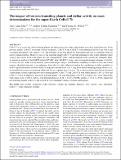Files in this item
The impact of two non-transiting planets and stellar activity on mass determinations for the super-Earth CoRoT-7b
Item metadata
| dc.contributor.author | Anna John, Ancy | |
| dc.contributor.author | Cameron, Andrew Collier | |
| dc.contributor.author | Wilson, Thomas George | |
| dc.date.accessioned | 2022-08-10T14:30:22Z | |
| dc.date.available | 2022-08-10T14:30:22Z | |
| dc.date.issued | 2022-09-01 | |
| dc.identifier | 280811493 | |
| dc.identifier | 2f0ac879-e6ff-49bb-bc54-120d2e734e6a | |
| dc.identifier | 000838819700006 | |
| dc.identifier | 85136270017 | |
| dc.identifier.citation | Anna John , A , Cameron , A C & Wilson , T G 2022 , ' The impact of two non-transiting planets and stellar activity on mass determinations for the super-Earth CoRoT-7b ' , Monthly Notices of the Royal Astronomical Society , vol. 515 , no. 3 , pp. 3975-3995 . https://doi.org/10.1093/mnras/stac1814 | en |
| dc.identifier.issn | 0035-8711 | |
| dc.identifier.other | ORCID: /0000-0002-8863-7828/work/117211241 | |
| dc.identifier.other | ORCID: /0000-0001-8749-1962/work/117211267 | |
| dc.identifier.other | ORCID: /0000-0002-1715-6939/work/117211332 | |
| dc.identifier.uri | https://hdl.handle.net/10023/25813 | |
| dc.description | Funding: AAJ acknowledges the support from World leading St Andrews Doctoral Scholarship. ACC and TGW acknowledge support from STFC consolidated grant numbers ST/R000824/1 and ST/V000861/1, and UKSA grant number ST/R003203/1. | en |
| dc.description.abstract | CoRoT-7 is an active star, whose orbiting planets and their masses have been under debate since their initial detection. In the previous studies, CoRoT-7 was found to have two planets, CoRoT-7b and CoRoT-7c with orbital periods 0.85 and 3.69 d, and a potential third planet with a period ∼9 d. The existence of the third planet has been questioned later as potentially being an activity-induced artefact. Moreover, mass of the transiting planet CoRoT-7b has been estimated to have widely different values owing to the activity level of the parent star, the consequent RV ‘jitter’, and the methods used to rectify this ambiguity. Here, we present an analysis of the HARPS archival RV (RV) data of CoRoT-7 using a new wavelength-domain technique, SCALPELS, to correct for the stellar activity-induced spectral line-shape changes. Simultaneous modelling of stellar activity and orbital motions, identified using the l1- periodogram, shows that SCALPELS effectively reduce the contribution of stellar variability to the RV signal and enhance the detectability of exoplanets around active stars. Using KIMA nested-sampling package (Faria et al.), we modelled the system incorporating a Gaussian Process together with SCALPELS. The resultant posterior distributions favoured a three-planet system comprising two non-transiting planets, CoRoT-7c and CoRoT-7d with orbital periods 3.697 ± 0.005 and 8.966 ± 1.546 d, in addition to the known transiting planet. The transiting planet CoRoT-7b is found to be a rocky super-Earth with a mass of Mb = 6.06 ± 0.65M⊕. The determined masses of Mc = 13.29 ± 0.69M⊕ and Md = 17.14 ± 2.55M⊕ suggest the non-transiting planets CoRoT-7c and CoRoT-7d to be structurally similar to Uranus and Neptune. | |
| dc.format.extent | 21 | |
| dc.format.extent | 6943207 | |
| dc.language.iso | eng | |
| dc.relation.ispartof | Monthly Notices of the Royal Astronomical Society | en |
| dc.subject | Line: profiles | en |
| dc.subject | Techniques: radial velocities | en |
| dc.subject | Planets and satellites: detection | en |
| dc.subject | Stars: activity | en |
| dc.subject | Stars: individual: CoRoT-7 | en |
| dc.subject | (Stars:) planetary systems | en |
| dc.subject | QB Astronomy | en |
| dc.subject | QC Physics | en |
| dc.subject | DAS | en |
| dc.subject | MCC | en |
| dc.subject.lcc | QB | en |
| dc.subject.lcc | QC | en |
| dc.title | The impact of two non-transiting planets and stellar activity on mass determinations for the super-Earth CoRoT-7b | en |
| dc.type | Journal article | en |
| dc.contributor.sponsor | Science & Technology Facilities Council | en |
| dc.contributor.sponsor | Science & Technology Facilities Council | en |
| dc.contributor.sponsor | Science & Technology Facilities Council | en |
| dc.contributor.institution | University of St Andrews. School of Physics and Astronomy | en |
| dc.contributor.institution | University of St Andrews. St Andrews Centre for Exoplanet Science | en |
| dc.identifier.doi | https://doi.org/10.1093/mnras/stac1814 | |
| dc.description.status | Peer reviewed | en |
| dc.identifier.grantnumber | ST/R00824/1 | en |
| dc.identifier.grantnumber | ST/R003203/1 | en |
| dc.identifier.grantnumber | ST/V000861/1 | en |
This item appears in the following Collection(s)
Items in the St Andrews Research Repository are protected by copyright, with all rights reserved, unless otherwise indicated.

